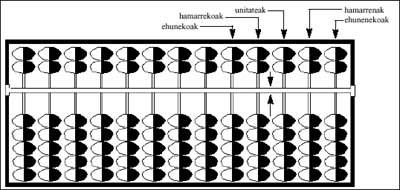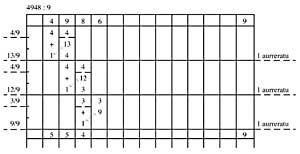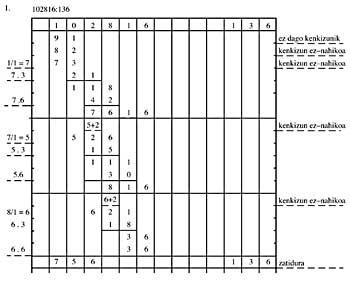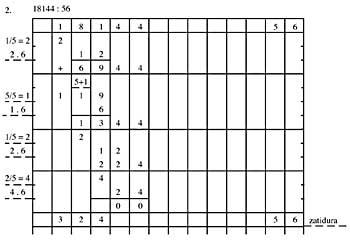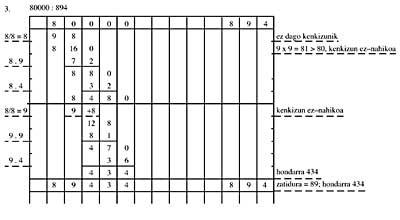Regulation of use of the Chinese abaco (II). Division
Elhuyar. In number 43 “Science and Technology”, in the Chinese abacus we gave all the instructions to add, subtract and multiply. On this occasion, we will deal with the rules for the division into the Chinese abacus and those needed to obtain square and cubic roots.
Simple division
This is the case that the divider is less than 10 and the product will not be used. We will use the following words:
advance - raise the balls
in the left column
Regulations
Part:
a part, advance 1; two parts, advance 2; ..; nine parts, advance 9.
Two parts:
one by two in the same column 5 (replace 1st by 5); two by two, 1 forward; three by two (3 = 2+1), 1 forward (2/2), two by three and (1/2) in the same column 5; four by two, 2 forward; ..; nine by two (9 = 8+1), 4 forward, 8 by nine and (1/2) in the same column.
Divided by
three:one by three in the same column, 3 plus 1; two parts in the same column, 6 plus two; three parts three, 1 forward; four parts (4 = 3 + 1), 1 forward (3/3), 3 in the same column, plus 1 (1/3); ...
Part four:
one divided by four, 2 in the same column, plus 2; two flat parts, 5 in the same column; three parts four, 7 in the same column, plus 2; four parts four, 1 forward;...; nine parts four (9 = 8 + 1), 2 forward (4/8), 2 in the same column, plus 2 (1/4).
Part five: one by five,
2 in the same column; two by five, 4 in the same column; three by five, 6 in the same column; four by five, 8 in the same column; five by five, 1 in advance; ..; nine by five (9 = 5+4), 1 in advance (5/5), 8 in the same column (4/5).
Divide six:one by six,
1 in the same column, plus 4; two parts six in the same column, plus 2; three parts in the same column, six in the same column; four parts six in the same column, 6 in the same column, plus 4; five parts six in the same column, 2; six parts, 1 forward; ..; nine parts six (9 = 6+3), 1 forward in the same column 5.
Part seven:one by seven,
1 in the same column, plus 3; two by seven, 2 in the same column, plus 6; three parts by seven, 4 in the same column, 2; four parts by seven, 5 in the same column, plus 5; five parts by seven, 7 in the same column, plus 1; six parts by the same column, 8 by 4; seven parts by seven, 1;...
Part eight:one by eight, in the same column 1, plus 2; two by eight, in the same column 2, plus 4; three by eight, in the same column 3; four by eight, in the same column 5; five by eight, in the same column 6, plus 2; six by eight, in the same column 7, plus 4; seven by eight, in the same column 8, plus 6; eight parts eight,
1 advanced; nine parts (9=8).
Part nine:one
between nine, 1 in the same column, plus 1; two parts nine, 2 in the same column, plus 2; three parts nine, 3 in the same column, plus 3; ..; eight parts nine, 8 in the same column, plus 8; nine parts nine advanced.
Observations
Note 1: If in the right column the ball rises more than 9, you can't raise that tenth in the left column. It must be divided by memory.
By dividing the dividend it is located to the left leaving a free column. The divider will be placed on the right.
4/9{ 4 in the same column, plus 4 in the right column, 9+4
= 13;13/9 = 9+4, (9+3)/9, 1 in the same column 4; 4/9 in the same column, plus
4 in the right column, 8+4
= 12;12/9 in column 12 = 9+3, (9+4)/9; 3 in the same column; 3/9, plus
3
9/9 progress
Note 2: If once the last figure is divided, the quotient is not accurate, the sand will be in its right column (column of dividend units).
Exercises:
123456789: 4 :5; 6; 7; 9; 3936: 4; 998651: 7; 519256: 8; 125476: 2
Long division
This is the case in which the divider is greater than 10.
This operation combines simple division, multiplication and subtraction. As before we started on the left.
General rule:
divide the first dividend figure by the first divider.
Place the partial quotient in the corresponding column and multiply by the following divisor figures (one by one) and subtract the results (one by one) from the dividend figures
in the corresponding columns.
This general rule has a problem by multiplying a partial quotient by a divisor figure when it is higher than the corresponding dividend figure. In this case the partial quotient is subtracted 1, 2, .., until the partial quotient “new” multiplied by the divisor figure below the dividend figure.
insufficient number in deductions, when the dividend figure is lower than the dividend, partial ratio and divisor figure product.
there is no right to deduce if in partial suppression we
have no right to deduce the partial coction of
the balls in the right column
Regulations
The following rules should be added to the rules of simple division and used when the first dividend and divider figures are equal, both when the minute is insufficient and when there is no right to deduction.
| Part one: there is no insufficient discount |
9 in the same column plus 11 removed plus 1 |
| Two parts: no fiscally deductible |
|
| Three parts three: no insufficient discount |
9 in the same column plus 31, plus 3 |
Four flat parts: |
9 in the same column plus 41 deleted plus 4 |
| Five parts five: no fiscally deductible |
|
Six parts six: |
9 in the same column plus 61, plus 6 |
Seven parts seven: |
9 in the same column plus 71, plus 7 |
| Eight pieces eight: no fiscally deductible |
|
| Nine parts nine: there is no insufficient deduction amount |
9 in the same column plus 91, plus 9 |
Examples
1. Example: Information
If we make 1/1 = 1 we would remain without deductions in order to eliminate 1.3 (00 - 1.3). Therefore, according to the rules, we must write 9 in the same column and 1 in the right.
If we make 9/1 = 9, the difference we have would be less than 12, 9.3, that is, the minute is not enough. Therefore, at quotient 9 we will subtract 1 and place it in the right column.
Doing 8/1 = 8 would have the previous problem. Therefore, at ratio 8, we remove 1 and place it in the right column.
7/1 = 7; 7.3 = 21. As the minuendo now is 32, 32 - 21 = 11
7.6 = 42, the minute is now 118. After 118 to 42 = 76.
Here the first partial division
Doing 7/1 = 7 or 7/1 = 6, the minuendo would be too small to remove 7.3 or 6.3.
7/1 = 5; 5.3 = 15 the minute is 26, 26 - 15 = 11
5.6 = 30, deductible 111. Therefore 111 - 30 = 81
8/1 = 6 for previous causes, since the deduction is insufficient.
6.3 = 18, being the minute 21, 21 - 18 = 3
6.6 = 36, 36. Thus, from 36 to 36 = 0. Quotient 756.
Observations
Although in each column there are 7 (2/5) balls, they are usually indicated up to 9 points. If some intermediate calculations have to indicate more than 9 points in the same column (16 in example 3 in the second step and 12 in the eighth), special values can be given to the balls to achieve that amount (10 in the case of 16 in the upper and 2 in the lower balls (16 = 1.10+3.2) in case 12, 5 and 1, but using more balls (12 = 2.5 + 2.1).
To differentiate the quotient from the divisions of the remainder, or from the tenth, one must know where the units of the quotient remain: if the divisor has a figure, the units of the quotient will be in the first column on the left of the units of the dividend; if the divider has two figures in the second column on the left of the units, if it has three in the third column; etc.
Exercises:
1386: 21; 6473: 37; 749653: 721; 563217: 721; 150475: 5122; 4820805: 62413: 344.40: 28; 8383.20: 65



